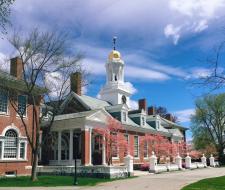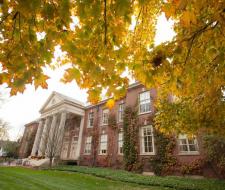Study in State of Massachusetts - top 138 institutions in State of Massachusetts
-
 One of the most selective schools in the USA
One of the most selective schools in the USA USABoston, MassachusettsCurrently watching: 10from 61950.00 $ / year
USABoston, MassachusettsCurrently watching: 10from 61950.00 $ / year -
 from 29130.00 $ / semester
from 29130.00 $ / semester -
 According to information for 2019, 78% of graduates received grades 5-4 for AP subjects
According to information for 2019, 78% of graduates received grades 5-4 for AP subjects USABoston, MassachusettsCurrently watching: 9from 58714.00 $ / year
USABoston, MassachusettsCurrently watching: 9from 58714.00 $ / year -
 from 67850.00 $ / year
from 67850.00 $ / year -
 According to information for 2019, an average SAT score made up 1410
According to information for 2019, an average SAT score made up 1410 USABoston, MassachusettsCurrently watching: 9from 64640.00 $ / year
USABoston, MassachusettsCurrently watching: 9from 64640.00 $ / year -
 from 37000.00 $ / year
from 37000.00 $ / year -
 from 27250.00 ₽ / year
from 27250.00 ₽ / year -
 Ranked #1 in QS World University Rankings 2023
Ranked #1 in QS World University Rankings 2023 USABoston, MassachusettsCurrently watching: 10from 6299.00 $ / 2 weeks
USABoston, MassachusettsCurrently watching: 10from 6299.00 $ / 2 weeks -
 from 65925.00 $ / year
from 65925.00 $ / year -
 In 2019 an average SAT score made up 1180
In 2019 an average SAT score made up 1180 USABoston, MassachusettsCurrently watching: 6from 28875.00 $ / semester
USABoston, MassachusettsCurrently watching: 6from 28875.00 $ / semester
Studying in Massachusetts, home to dozens of globally renowned universities like Harvard University and MIT, has always been a coveted choice for students worldwide. A 2023 study by WalletHub demonstrated that the state's public school system ranks best in the U.S. across parameters such as quality of education, safety, and per-capita funding. Both public and private schools in the state also excel in math and reading test scores. Moreover, education here is among the least traumatic; students in the Commonwealth are least susceptible to threats and violence.
Alternative destinations
Advantages of education in Massachusetts
In 2018, 2020, and 2022, the state's education system was named the best by the prestigious US News & World Report. Massachusetts consistently ranks at the top in national assessments across many metrics.
For instance, Massachusetts is home to America's oldest continuously operating school, Roxbury Latin School, founded in 1645. It also houses the oldest elementary school, The Mather School (founded in 1638), Boston Latin School (established in 1635), the oldest continuously functioning boarding school, Governor's Academy (founded in 1763), the oldest institution of higher learning, Harvard (founded in 1636), and the oldest women's college, Mount Holyoke (founded in 1837).
However, a rich history doesn't imply that all the best in Massachusetts education comes at a steep price. The highest-ranked private school in the U.S., Phillips Academy in Andover, was founded 250 years ago in 1778. As mentioned earlier, Massachusetts students consistently achieve top scores in math and reading in national assessments; public school students have been in the top ten for academic performance since 1986.
In addition to Harvard and MIT, perennially ranking among the world's best private universities, the state hosts another 120 universities, some of which also hold high positions in rankings. For example, in the top fifty U.S. universities for undergraduate programs according to the 2023 US News & World Report, Tufts University ranks 27th, Boston College 32nd, Brandeis University 34th, Boston University 37th, and Northeastern University 40th.
Traditionally, the state's universities excel in humanities and social sciences. According to the US News & World Report, 3 out of the top 5 universities in this category are located in Massachusetts: Williams College and Amherst College (first and second), and Wellesley College (fourth).
Additionally, the state is home to the country's oldest Catholic college, College of the Holy Cross (33rd in the national rankings), and the largest non-state architectural and design college, Boston Architectural College. Massachusetts State University, with its five campuses and 30,000 students, is the largest in New England.
Cost of education in Massachusetts schools and universities
Foreign students cannot attend state and charter schools, but any of the state's 967 private schools welcome students from Russia. However, this pleasure is not cheap: on average, tuition for a year at a boarding school will cost at least $40,000, with the best schools being more expensive.
Day school education in Massachusetts costs less (from $28,000), but students will need to pay for homestay accommodation and meals, among other less obvious expenses.
Education in Massachusetts: History
Massachusetts' public elementary and secondary education system is the oldest in the U.S. It dates back to 1647 when the colony passed the Massachusetts Education Law, which required local authorities to appoint teachers or open grammar schools — until then, colonists resorted to traditional formats: homeschooling, church, apprenticeship. Puritan authorities motivated the introduction of universal education in Massachusetts by the necessity to teach every child to read the Holy Scriptures.
The first schools were for boys, and only in the early 18th century co-educational schools replaced them. Education was paid for but partially subsidized by local authorities. In major cities like Boston or New Haven, grammar schools, precursors to modern secondary schools, were opened. By 1800, the state had a network of several dozen elite private schools that later grew into preparatory schools.
The origins of higher education in the state were also religious. Harvard College, founded in 1636, was a localized copy of Oxford designed to train colonial administrators and young priests. Financing came from colonial authorities and donations, with the share of non-state funds rising from 9% in 1670 to 44% in 1780.
In 1734, the first boarding school for Indians appeared in Stockbridge, but mismanagement and corruption led to the closure of the last such school by 1754. Massachusetts did not attempt to open Indian schools anymore.
The school remained traditional and archaic until 1839 when the state attempted to create Prussian-style "normal schools" but with a Republican theme instead of German Ordnung. They could have been a failure: opposition argued it was a waste of money, and many ordinary Americans believed education in Massachusetts was sufficient for the elite, with 9 out of 10 residents getting along fine without it.
The reform of secondary education in Massachusetts is firmly associated with the name of Horace Mann — the most influential educator in the U.S. in the 19th century and an advocate of the idea of universal education for white people. He believed it would be an important step towards democratizing society and promoting economic development. Soon, the new model proved its effectiveness, and the movement of public schools gradually spread to the Northeast and West of the U.S. Its activists insisted on creating a network of elementary schools funded by local taxes, and Mann promoted the idea of professional teacher training. By 1860, Massachusetts had 13 such schools where young women and men could earn a teaching diploma in two years.
Another prominent educator from Massachusetts, Francis Parker, while serving as the school director in Quincy, believed in developing a child's personality comprehensively, not limiting them to rote learning. The combination of play-based approaches, informal methods, and group activities yielded excellent results — Quincy students outperformed students from all other schools in the state.
In the late 19th century, the state was one of the first to abandon Latin and Greek, replacing them with natural sciences and new languages, primarily German and Spanish (French replaced German after World War I). In the early 1920s, the state invested in expanding the range of extracurricular activities available to students — from choir and light athletics to the first mass debate league in the U.S. and a network of school newspapers, for which the government purchased 167 printing presses. A little later, Massachusetts became the first state in the U.S. to equip all municipal schools with computers by 1988.
In the 1930s, Massachusetts saw the emergence of a network of free municipal children's libraries, and where it was economically impractical, library bus routes were laid. Finally, in the 1960s and 1970s, state schools and colleges took the forefront in the fight against racial segregation, and in 1974 initiated a process in the Supreme Court that declared the segregation law unconstitutional.
